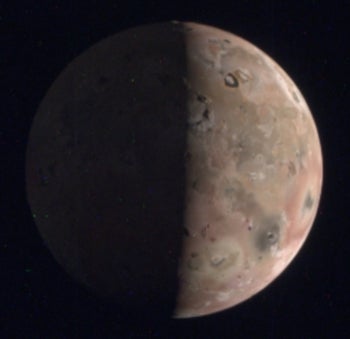Arizona telescope's sharper optics reveal spectacular images of Io, Jupiter's volcanic moon

Jupiter moon Io, imaged by SHARK-VIS on Jan. 10, 2024. This is the highest-resolution image of Io ever obtained by an Earth-based telescope. Image credit: INAF/Large Binocular Telescope Observatory/Georgia State University; IRV-band observations by SHARK-VIS/F. Pedichini; processing by D. Hope, S. Jefferies, G. Li Causi
Since 1979, when Jupiter's moon lo was found to be covered in volcanoes, astronomers and volcanologists have been fascinated by what this reddish satellite could reveal about the evolution of the Jovian systemAltogether, Jupiter's moons form a satellite system called the Jovian system. and Earth's early volcanic history. However, the study of Io's eruptions and lava flows has been hindered by the low resolution of images from earthbound and space telescopes, and the limited number of close-ups from NASA flyby spacecraft.
Recently, a new high-contrast optical imaging instrument, SHARK-VIS, was installed on the Large Binocular Telescope (LBT) on Mount Graham in Arizona. Combined with the telescope's adaptive optics system, this instrument has produced the highest-resolution optical images of lo ever taken from Earth.
These images, recently published in the journal Geophysical Research Letters, were reported by a team of astronomers and engineers, including Arizona State University’s David Williams, research professor in the School of Earth and Space Exploration and the director of the Ronald Greeley Center for Planetary Studies, and David Nelson, data manager of the Ronald Greeley Center for Planetary Studies.
The new images are sharp enough to distinguish volcanoes so close together that the debris from their eruptions overlaps. The resolution of the images is about 50 miles across, akin to photographing a dime from 100 miles away. This resolution is two to three times better than what the Hubble Space Telescope, a renowned space-based observatory, can achieve in its observations of lo.
With the new capabilities on the SHARK-VIS instrument, researchers are now able to view detailed images and identify a significant resurfacing event involving two of Io's volcanoes, Pele and Pillan Patera. The images show deposits from Pillan Patera covering the plume deposit around Pele, a phenomenon previously observable only with spacecraft like NASA’s Voyager and Galileo.
Slightly larger than Earth's moon, lo is the innermost of Jupiter's Galilean moons, which, in addition to lo, include Europa, Ganymede and Callisto. Locked in a gravitational "tug of war" among Jupiter, Europa and Ganymede, Io is constantly being squeezed, leading to frictional heat buildup in its interior — believed to be the cause for its sustained and widespread volcanic activity.
"The ability to detect large-scale surface changes by volcanic activity on Io in visible light using the SHARK-VIS instrument is a major advance," Williams said. "We no longer require a spacecraft in the Jupiter system to identify surface changes from large eruptions — we can do so from Earth with adaptive optics and SHARK-VIS."
The success of SHARK-VIS now opens new possibilities for observing other solar system bodies, including the moons of giant planets and asteroids. This advancement in high-resolution imaging will help astronomers and volcanologists understand volcanic processes not only on Io but potentially on exoplanetary bodies as well, offering a window into the past volcanic activity of Earth and other planets.
SHARK-VIS was built by the Italian National Institute for Astrophysics at the Rome Astronomical Observatory and is managed by a team led by Principal Investigator Fernando Pedichini, assisted by Project Manager Roberto Piazzesi. In 2023, it was installed, together with its complementary near-infrared instrument SHARK-NIR, at the LBT to fully take advantage of the telescope's outstanding adaptive optics system. The instrument houses a fast, ultra-low-noise camera that allows it to observe the sky in "fast imaging" mode, capturing slow-motion footage that freezes the optical distortions caused by atmospheric turbulence, and to postprocess data to an unprecedented sharpness.
The international research team includes Al Conrad, Jennifer Power, Steve Ertel, Joseph C. Shields, Sam Ragland and Jason Perry of the University of Arizona; Fernando Pedichini, Gianluca Li Causi, Simone Antoniucci, Roberto Piazzesi, Vincenzo Testa, Piero Vaccari and Fabrizio Giorgi of INAF Osservatorio Astronomico di Roma; Martina Vicinanza of INAF Osservatorio Astronomico di Roma and INAF-ADONI Adaptive Optics National Laboratory; Imke de Pater of the University of California, Berkeley; Ashley Gerard Davies of the Jet Propulsion Laboratory, California Institute of Technology; Katherine de Kleer of the California Institute of Technology; Stuart M. Jefferies of Georgia State University; and Douglas Hope of Georgia Tech Research Institute.
Press release written by University of California and University of Arizona with contributions from Kim Baptista at Arizona State University’s School of Earth and Space Exploration.
More Science and technology

ASU researcher part of team discovering ways to fight drug-resistant bacteria
A new study published in the Science Advances journal featuring Arizona State University researchers has found vulnerabilities in certain strains of bacteria that are antibiotic resistant, just…

ASU student researchers get early, hands-on experience in engineering research
Using computer science to aid endangered species reintroduction, enhance software engineering education and improve semiconductor material performance are just some of the ways Arizona State…

ASU professor honored with prestigious award for being a cybersecurity trailblazer
At first, he thought it was a drill.On Sept. 11, 2001, Gail-Joon Ahn sat in a conference room in Fort Meade, Maryland. The cybersecurity researcher was part of a group that had been invited…
